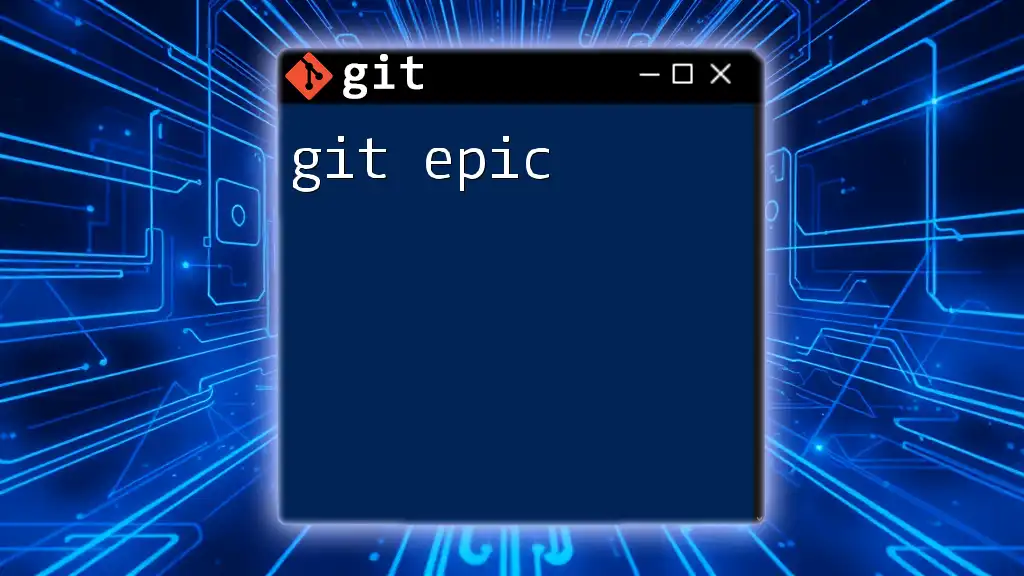Git metrics refer to the quantitative measures derived from your Git repository, such as commit frequency, contributor activity, and code churn, which can help assess project health and team productivity.
Here's an example command to view commit statistics:
git shortlog -sn --all
Understanding Git Metrics
What are Git Metrics?
Git metrics are quantitative measurements that help gauge the performance and health of software development projects managed with Git. These metrics are essential for understanding team productivity, code quality, and overall project health. By analyzing these metrics, teams can make informed decisions that improve their development processes.
Why Are Git Metrics Important?
Monitoring Git metrics provides significant advantages in software development workflows:
- Improved project management: By leveraging metrics, teams can better plan sprints, allocate resources, and track progress against goals.
- Enhanced team collaboration: Metrics help identify bottlenecks and opportunities for improvement, fostering a more collaborative environment.
- Better quality control: Teams can utilize metrics to manage technical debt, highlighting areas requiring immediate attention and ongoing improvement.

Key Git Metrics to Track
Commit Metrics
Commit Frequency
Commit frequency refers to the number of commits made to a repository over a specified time period. This metric is essential because it helps teams understand their activity levels and productivity.
To measure commit frequency, you can use the following command:
git rev-list --count HEAD
This command will provide the total number of commits in the current branch. Regular analysis of commit frequency can indicate team engagement, revealing patterns that may correlate with project success or delays.
Commit Size
Commit size is another vital metric, representing the amount of code or changes integrated into the repository with each commit. Large commits can complicate code reviews and increase the potential for bugs, making it crucial to keep commits focused and small.
You can analyze the size of your last commit using:
git diff HEAD~1 HEAD
This command shows the differences between the last commit and the one before it, allowing developers to understand the volume of changes submitted.
To maintain manageable commit sizes, aim for focused changes that align with specific tasks or issues.
Commit Message Quality
The quality of commit messages is integral to understanding historical decisions and navigating code. Clear, descriptive commit messages enhance project maintainability and facilitate effective communication within the team.
Encourage your team to follow best practices when writing commit messages, such as:
- Including a short summary of changes.
- Describing the "why" behind the changes.
- Referencing issue numbers when applicable.
Using tools such as CommitLint can help analyze and enforce consistent commit message standards across your projects.
Contributor Metrics
Number of Contributors
Tracking the number of contributors on a project provides insight into the level of collaboration and interest in a repository. A diverse contributor base often indicates a healthy project ecosystem.
To measure the number of contributors, you can use:
git shortlog -sne
This command summarizes contributions, listing developers alongside their commit counts, giving you visibility into your team's contributions.
Contributor Activity
Assessing individual contributor activity can reveal engagement levels and highlight areas needing support. Analyzing activity over time allows for identifying trends, such as periods of high or low contribution.
For example, you can visualize contributions from a specific author with the following command:
git log --author="name" --oneline --since="1 month ago"
This will display all commits made by that contributor within the last month, enabling effective monitoring of contributions.
Branch and Merge Metrics
Branch Creation and Deletion
Understanding the lifecycle of branches helps manage project complexity and encourages best practices for version control. Analyzing branch creation trends can indicate areas of the project that might require more focus or attention.
You can list branches sorted by the most recent commits with this command:
git branch --sort=-committerdate
This will help visualize active branches and inform consolidation or cleanup efforts.
Merge Frequency
Regular merges are critical for maintaining project integration and helping teams stay aligned. Tracking the frequency of merges can indicate the pace at which features or bug fixes are being integrated into the project.
To measure merge activity, use:
git log --merges
This command lists all merge commits, making it easy to see how often merges are occurring and when significant changes have been integrated.

Advanced Git Metrics
Code Quality Metrics
Code Complexity
Code complexity is an important measurement that assesses how complicated code structures are. High complexity often leads to more bugs and difficulties during maintenance. Tools such as SonarQube can help analyze code complexity and other quality metrics.
By integrating such tools into your CI/CD pipeline, you can continuously monitor your code’s health alongside commit metrics, enabling proactive management of project quality.
Code Churn
Code churn represents the frequency of changes made to a specific area of codebase and can be used to identify instability or volatility in the source code. Monitoring code churn is essential for maintaining project stability, as high churn often indicates that a part of the code requires more attention or review.
Use the following command to measure code churn:
git diff --shortstat HEAD~10..HEAD
This command compares the number of lines added and deleted in the last ten commits, providing visibility into recent activity levels.
Pull Request Metrics
Pull Request Lifecycle
Analyzing the lifecycle of pull requests, from creation to merging, can uncover delays in the review process or identify areas that require additional resources.
To measure the time taken for a pull request's lifecycle, you may need to use the GitHub API or similar tools. Monitoring this metric helps improve your development workflow by encouraging prompt reviews and quicker integration of contributions.
Review Metrics
Measuring review metrics involves analyzing feedback patterns on pull requests, primarily focusing on the number of comments per pull request. Strong feedback cycles enhance code quality and developer growth.
Linking review metrics with commit quality pushes for better feedback practices. Tracking comments is extensively beneficial for mentoring new team members or spotting potential issues within the team's collaboration.

Implementing a Git Metrics Strategy
Setting Goals
Establishing clear goals for tracking Git metrics is essential for driving improvement in your development processes. Determine the objectives you want to achieve—like increased commit frequency, improved code quality, or enhanced collaboration.
Align these goals with your team's performance indicators and project requirements to create a focused approach to improvement.
Tools for Tracking Git Metrics
Several tools exist to facilitate the tracking and analysis of Git metrics. Popular options include:
- GitStats: A tool for generating statistical reports based on git repositories.
- GitHub Insights: Provides visual graphs and metrics directly from GitHub repositories.
Evaluate the pros and cons of each tool based on your team's specific needs and set up the one that best fits your workflow.
Creating a Dashboard
Visualizing Git metrics through dashboards can significantly enhance your team's ability to monitor progress and identify areas requiring attention. Tools such as Grafana or Tableau can enable you to create custom dashboards that summarize key metrics, allowing for easier interpretation and ongoing analysis.

Interpreting and Acting on Git Metrics
Making Data-Driven Decisions
The ultimate goal of tracking Git metrics is to make data-driven decisions that enhance workflow efficiency and project health. Utilize insights gleaned from metrics to inform team practices, improve onboarding processes, or streamline code reviews.
Several case studies illustrate how teams have successfully implemented Git metrics, leading to greater efficiency and high-quality deliverables.
Pitfalls to Avoid
It is crucial to avoid common mistakes when interpreting Git metrics. Over-reliance on metrics without context can lead to misinformed decisions. Always complement quantitative data with qualitative insights from team discussions and retrospectives to ensure a well-rounded view of project health.

Conclusion
Recap of Git Metrics Importance
In summary, Git metrics provide invaluable insight into the health and performance of software projects. By understanding and monitoring these metrics, teams can navigate challenges and improve collaboration and productivity.
Final Thoughts
Encouraging teams to adopt a Git metrics strategy can lead to improved outcomes, higher code quality, and a more engaged development community. As you embark on this initiative, remember to consider the context behind the numbers and to adjust your strategies based on what you learn.

















